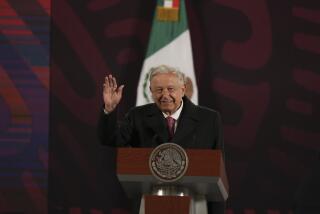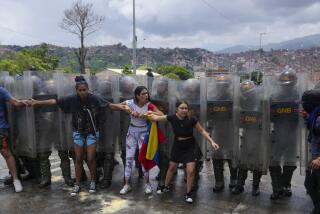Chamorro Is Running Strongly in Nicaragua : Elections: Early returns indicate that Ortega and Sandinistas may be headed for a stunning defeat.
MANAGUA, Nicaragua — Violeta Barrios de Chamorro, a widowed newspaper publisher, appeared headed for a stunning upset of Sandinista President Daniel Ortega in Sunday’s Nicaraguan elections, according to voting results collected and analyzed by the Los Angeles Times.
A Times projection based on vote tallies from a nationwide sample of representative polling places showed that Chamorro will get more than 50% of the votes and that Ortega will finish with a percentage in the low 40s.
It showed the 44-year-old Sandinista leader running virtually even with Chamorro, the strongest of his nine challengers, in Managua and Esteli but trailing her in Nicaragua’s seven other regions.
If confirmed by official returns, a victory by Chamorro’s U.S.-backed coalition would end a decade of rule by the Sandinistas who fought their way to power in a guerrilla war and allied themselves with the Soviet Bloc in a confrontation with Washington that led to an eight-year Contra war.
The election, the most contentious in Nicaragua’s history, ended with a heavy turnout, a slow vote count and a long official silence.
At 2 a.m. today, eight hours after the polls closed, the government’s Supreme Electoral Council announced the first returns. They showed Chamorro leading Ortega by 51.5% to 44% of the votes from 244 of the 4,391 polling places.
The Sandinistas postponed a scheduled midnight victory rally and Ortega held an urgent meeting with former U.S. President Jimmy Carter, who was here as an official election observer.
Chamorro’s 14-party National Opposition Union (UNO) projected a landslide victory for the 60-year-old publisher on the basis of returns from a nationwide sample of 450 polling places. It gave her 59% of the vote to 41% for Ortega.
The challenger and her running mate, Virgilio Godoy, greeted more than 50 applauding campaign workers and Chamorro relatives at her home early today. Limping in a brace for her broken kneecap and wearing a white dress, Chamorro led her guests in the national anthem and the Lord’s Prayer.
“The information available now is that the electoral council is indicating an ample victory for the UNO,” Godoy later told cheering supporters at UNO’s election headquarters. “Why are they holding up the results?”
The Sandinistas predicted victory shortly after the polls closed but announced no projections. As the evening wore on, tension set in at the ruling party’s headquarters.
“I don’t know what the nervousness is all about,” said Carlos Zaruk, a Sandinista army official. “Why aren’t we celebrating?”
The voting, aimed at ending eight years of guerrilla war, was heavy and remarkably peaceful throughout Nicaragua. Election officials said eight of the polling stations failed to open and two others were hastily transferred because of military activity by American-supplied Contras.
Both the Sandinistas and UNO reported what they called insignificant numbers of election law violations and said they felt buoyed by the big turnout.
“I think things have been going very smoothly,” said former U.S. Atty. Gen. Elliot L. Richardson shortly after the polls closed at 6 p.m. “So far, the elections look fair.” Richardson heads the U.N. observer mission and is one of more than 2,000 accredited vote monitors.
Ortega said after casting his ballot in Managua that he was certain of winning another six-year term and would invite President Bush to his inauguration.
“I expect that the government of the United States will recognize the results of the elections and work for peace with Nicaragua,” Ortega said.
Chamorro, the strongest of Ortega’s nine challengers, expressed her “faith in God and my people that Nicaraguans will vote for a change.”
Voters leaving the polls echoed both predictions with a certainty and emotion that reflected the highly charged expectations of a bitterly contested--but surprisingly peaceful--six-month campaign.
“God has pity on the Nicaraguan people, and He is going to change things,” said Mercedes Maldonado, 85, of Managua, who voted for the first time in her life. Bursting into tears, she told of how five of her children had left Nicaragua and how her sixth is ailing and cannot afford medicine. “My heart told me to vote for UNO,” she added. “We have to free ourselves from this hunger.”
Across the capital at a polling station near army headquarters, where scores of uniformed Sandinista soldiers lined up to cast ballots, Lt. Victor Brenis said he was voting for Ortega “to show imperialism that we have a democracy here.”
Ortega, 44, was first elected in 1984, five years after his Sandinista National Liberation Front seized power from President Anastasio Somoza to end 43 years of U.S.-backed dictatorship. Chamorro, 60, served nine months on the first Sandinista junta, then quit to turn her newspaper, La Prensa, into the country’s leading opposition voice.
For the Sandinistas, the election was an effort to prove the legitimacy of their revolution, end a decade of U.S. hostility and rebuild the country. UNO, an electoral alliance embracing both Communists and conservatives, saw the vote as a timely opportunity to repudiate what it calls a dictatorial system that has brought this fertile country of 3.5 million people to ruin.
Voters were choosing a president, a vice president, 90 members of a single-chamber National Assembly and, for the first time, 131 municipal councils. Two regional councils to govern the eastern part of the country, populated largely by English-speaking blacks and Miskito Indians, were also being elected.
About 1.75 million voters, age 16 and older, signed up for the election during a four-week registration period last October.
Richardson estimated the turnout at near 90%.
Many voters stood in line all night, waiting for polls to open at 7 a.m., only to find the voting process sluggish.
The Loyola Institute, the largest polling place in Managua, opened 1 hour and 45 minutes late because just two election officials were on hand to start counting the 6,669 paper ballots.
At the suggestion of former U.S. President Jimmy Carter, who visited the school as an election observer, more officials were brought in. When the iron gate finally opened, two voters were injured in the stampede.
“The people outside were legitimately concerned (about the delay),” Carter said. “But it will be done correctly even if it takes a long time.”
Voters cast separate ballots in three-sided cardboard booths bearing the promise “Your Vote Is Secret” in black letters. To prevent multiple voting, voters’ right thumbs were dipped in ink.
“It’s very solemn, like a Mass,” Carter said after watching election officials lay out ballots, registration books and ink on a table in one polling station.
UNO’s main complaint was that the ink, supposedly indelible, was easily washed off by many voters. But Richardson said, “I don’t think it’s a fatal flaw, because there are too many other checks in the system. It’s not probable that the vote was affected in any significant way.”
In a preliminary evaluation, the opposition denounced irregularities at seven polling stations. It said Sandinista officials padded registration lists, allowed Sandinista soldiers to go ahead of other voters in line, obliged voters to show their ballots and annulled those marked for opposition candidates.
Opposition leaders also charged that some of the polling stations affected by reported Contra activity were really kept closed to prevent voting in rural war zones in favor of UNO. Witness for Peace, a Washington-based group that monitors the Contras, said there had been no recent rebel activity near the polling station at El Toro, in Matagalpa province, where 1,300 people were kept from voting.
The Sandinistas, in turn, accused UNO supporters of violating the law against politicking at the polls.
But the complaints were overshadowed by optimism on both sides that the heavy turnout had favored their candidates.
The government invited observers from 160 foreign groups to monitor the vote, and they tried to cover most of the polling stations.
Times reporters who visited rural areas of Chontales and Jinotega provinces recently infiltrated by the Contras encountered few international observers but saw large, peaceful turnouts of eager voters, including unarmed Sandinista soldiers.
“What has happened in this country is that we Nicaraguans have become strangers to each other,” said Fernando Giacom Gomez, a farmer in the village of El Ayote, in Chontales. “Whoever wins, what we need is peace.”
Carter said that if the election is judged to be fair, it would remove the rationale for any further American aid to the rebels or remove the government that the rebels oppose. Either result, he said, would permit the United States to end a five-year economic embargo and to normalize relations with a Nicaraguan government enjoying popular support.
The election was the first in Nicaragua to be contested by all political forces. Amid dying prospects for a resumption of U.S. military aid to the Contras, which was cut off two years ago, several rebel leaders returned from exile to help found UNO last May, making it a broad anti-Sandinista coalition.
Just once in Nicaragua’s bloody history, in 1928, has power passed from one party to another through the ballot. Historically, elections were viewed as rigged instruments to perpetuate the party in power.
The 1984 election, which gave Ortega two-thirds of the vote, was marred by the pullout of the main U.S.-backed opposition bloc. Its leaders still claim that unfair campaign conditions made the Sandinistas unbeatable. But many of them, now in UNO, say their decision was an error that plunged the nation into its worst years of war.
Anti-Sandinista politicians were thrust to the front of the conflict in February, 1989, when a peace agreement among Central American presidents moved Nicaragua’s 1990 elections forward by nine months in exchange for a plan, still unfulfilled, to close the Contra camps in Honduras.
Last September, the 14-party coalition united behind Chamorro and received pledges of $3.3 million in U.S. government aid.
Chamorro’s campaign stressed the sacrifices of her slain husband, Pedro Joaquin Chamorro, the best-known victim of the struggle against Somoza. She appealed for reconciliation of a divided nation and called for an end to compulsory military service.
Focusing on Nicaragua’s severe economic decline, which has cut real wages by more than 90% since 1981 and driven forced large numbers of people into poverty, Chamorro also promised an economic revival driven by greater freedom for private capital.
Sandinista candidates, saying the crisis had been stabilized, blamed it on the Contra war and the U.S. embargo, rather than mismanagement.
And they used their economic battles with the United States to wage a nationalist campaign against Chamorro’s American-financed coalition, calling her a stalking horse for yanqui imperialism. Sandinistas claimed that some UNO leaders were closely tied to the Somoza regime and the estimated 3,000 Contras still fighting inside Nicaragua.
Ortega abandoned his olive-green uniform and stern bearing to stump vigorously across the country as a youthful populist. He danced the limbo, hugged babies, tossed baseballs into crowds and handed out land titles by the thousands.
Adapting a U.S.-style campaign, his party outspent UNO, clothed much of the country with “Daniel for President” T-shirts and dominated the media and the billboards. It mustered the vast resources of the state to produce campaign rallies somewhat larger than those greeting Chamorro.
In the closing weeks of the race, Ortega preempted one of Chamorro’s key campaign promises by freeing the last 1,190 prisoners condemned for crimes against the state.
Peace OFFERING: Bush says the U.S. is ready to improve relations. A4
YOUTHFUL PATRIOTS
Emigres return to Lithuania to work for independence. A6
More to Read
Sign up for Essential California
The most important California stories and recommendations in your inbox every morning.
You may occasionally receive promotional content from the Los Angeles Times.










